As the Russian Caucasian army defeated the Turkish army 3 th in Erzincan battle
100 years ago, 17 May 1916, the Erzincan battle began. The strategic defeat of the Turkish army in the Erzerum operation and the successful Russian offensive on the Trabzon direction led the Turkish high command to take measures to strengthen the 3 army and transfer the 2 army to the Caucasus in order to launch a decisive offensive. On May 17, the Turkish army launched an offensive in order to retake the lost territory. However, the Turkish troops could not break the resistance of the Russian army and suffered a new defeat.
19 June - 5 July counterstrokes on the 3 sectors of the front Russian stopped the offensive of the Turkish troops and rejected them in their original position. On July 6, the troops of the Caucasian army launched a counterattack on all fronts, culminating in the defeat of the Turkish 3 Army Vechy Pasha. On July 12, our troops occupied Erzincan, abandoned by the Turks without a fight. As a result of the Erzindzhan operation, the Caucasian army, having advanced in a band over 200 km to a depth of 130 km, significantly improved its operational position.
prehistory
December 1915 - February 1916 The Russian army carried out a successful Erzerum offensive, as a result of which Russian troops broke through the Turkish defense and in the main line came to Erzerum, the main and supporting base of the Turkish army in the Caucasus. The assault on the fortress began on January 29 (February 11). 3 (16) February Erzerum was taken, the Turkish army was defeated and fled, having lost up to 70% of personnel and almost all the artillery. The pursuit of the retreating Turkish troops continued until the front line stabilized 70-100 km west of Erzerum. 3-I Turkish army suffered a crushing defeat, and it had to be restored, throwing troops and reserves from other directions and fronts.
The actions of the Russian troops in other directions were also successful: the Russian troops approached Trebizond, the most important Turkish port, through which the supply of Turkish troops by sea went, won the battle against Bitlis. The spring thaw did not allow the Russian troops to completely crush the Turkish army retreating from Erzerum, but spring comes earlier on the coast of the Black Sea, and the Russian army began active operations there (Trapezundskaya operation). On April 5, after a series of successful battles, the most important port of Trebizond (Trapezond) was taken. Here they began to create a large army rear base. To protect it, a fortified area was created. Two third-order infantry divisions, formed near Mariupol, were transferred there. The commander of the Caucasian army Yudenich of them organized the 5-th Caucasian Army Corps. As subsequent events showed, it was a timely measure, ahead of the Turkish offensive. In the course of further battles, Russian troops expanded their bridgehead at Trebizond. This made it possible to create a threat to the left flank of the 3 of the Turkish army. By the summer of 1916, a large part of Western Armenia was taken under control by Russian troops.
The left wing of the Caucasian Army (Baratov's corps) assisted the British, advancing on Mosul and Kerman-Baghdad directions, drawing the enemy infantry divisions to 4, which, with the passivity of the Russians, would be thrown against the British in Iraq. The Russian command, in order to help an ally, ordered Baratov to launch an offensive and reach the posts of the 6 of the Turkish army in the area of Mosul and the valley of the Tigris River. Our troops launched an offensive on April 18 and captured Qasr-i-Shirin with battle, capturing huge stores of the Turkish army there. Turkish troops were pushed back to Hanekin within Iraq. However, the British did not take advantage of the successes of the Russian troops, which diverted the great forces of the Turks to themselves. They even refused to send any unit to meet the Russian intelligence Cossack hundred hundred centurion Gamaliya, who made a heroic rush to establish communication with the British. Having overcome all the difficulties of the path, the Russian hundred, to the amazement of the British 9, arrived at their headquarters in Iraq. In connection with the passivity of the British, Baratov was ordered to stop the movement, entrenched himself in the occupied positions, and then retreat, so as not to be under attack by the 6 of the Turkish army as the communications of the Russian corps lengthened to 900 km (from Enzeli on the Caspian Sea).
In this case, the British suffered a serious defeat. Three attempts by the British De-blockade Corps in April of the British De-blocking Corps to rescue General Townside’s group surrounded by Turkish forces in Kut-el-Amar failed. 1916 April, after the 28-day siege, Townside troops capitulated. The Ottomans surrendered 147 British generals, 5 thousand British and 3 thousand Indian soldiers, and more than 7 thousand soldiers serving the rear. Thus, the British campaign in Iraq, which lasted from November 3 to May 1914 in order to capture Baghdad without the participation of Russian troops, ended in complete collapse. This allowed the Turkish command to release part of the troops to fight the Russian army.
Before the battle. Forces of the parties
The Ottoman command did not accept the defeats in the Caucasus, and planned to take revenge, return the lost territories, Erzerum and Trebizond. Istanbul was preparing a powerful blow to the Caucasian army. Turkish troops in the Caucasus were significantly strengthened - from the 11 divisions they were brought to 24. To reinforce the 3 Army, the 5 and 12 Corps were transferred by sea, bringing its force to the 15 divisions. In the future, the number of 3 army planned to increase to 30-35 divisions. The army was led by a new commander, Mehmet Vehib Pasha. He was a member of the First Balkan War, during the First World War he successfully commanded the 15 Corps in Gallipoli, and then the 2 Army. The success of the Turkish troops in the Battle of Dardanelles led to the appointment of Jehip commander of the 3 army in the Caucasus. A skilled commander had to avenge his previous defeats. At the same time, on the right flank of the Caucasian Front, into the valley of the Euphrates, parts of the 2 Army Ahmet Izheta Pasha were transported along the Baghdad Railway. He was an experienced commander who fought with the Greeks and served in Syria, Hejaz and Yemen. In the 1908 year after the Revolution of the Young Turks, Ahmed Izzet Pasha was appointed Chief of the General Staff, and remained in that position until the 1914 year. He played an important role in the modernization of the Turkish army with the help of German advisers. The 2 th army consisted of: 2 th, 3 th, 4 th and 16 th corps. However, the concentration of the 2 Army was slowed down by poor communications, parts had to go their own way 250-600 km from the discharge stations to the concentration points.
The Turks knew about the location of the Russian troops through their agents from the local population. The 3-I Turkish army was to go on the offensive in July on the wide front of Trabesund - Erzerum and tie down Russian troops in the main Erzincan direction. The main blow was struck 2-I army Izzet-Pasha. The Ottomans planned to strike at the junction between the 1-m and 4-m Caucasian corps - on Gassan-Kala, here the Russians had only cavalry and small infantry units. Then the 2-I Turkish army was to attack Ognot and Kepri-kei, bypassing the left wing and the center of the main forces of the Russian army, to go to the rear of Erzerum from the southeast. The Ottoman command planned to repel Erzerum, and in case of great luck to surround and destroy the main forces of the Russian Caucasian army, which moved to the Erzincan direction far to the west. Subsequently, the Ottomans planned to reach the borders of 1914 and invade the Russian Transcaucasus.
The Turkish High Command had originally planned to launch the 2 Army’s advance as early as April 1916. However, due to the slow concentration of troops of the 2 Army, the operation had to be postponed due to the low carrying capacity of the Baghdad Railway. The railroad only reached the station Ras el Ain. Then the troops had to march hundreds of kilometers along difficult mountain roads to the concentration points. In addition, the German-Turkish command made mistakes in the calculations for the concentration of troops. As a result, the 2 Army was ready for an offensive only in mid-July 1916. The 3 Army had already entered the battle and was defeated, which weakened the strength of the Turkish strike. Thus, the Turkish High Command could not properly manage the available forces, correctly calculate the planned operation and ensure the interaction of the two armies, which ultimately led to their defeat in parts. This disrupted the widely conceived maneuver operation, to which selected troops were recruited, which participated in repelling the Anglo-French assault in the Dardanelles area.
Russian intelligence in time discovered the movement of enemy troops. In anticipation of the enemy offensive intelligence was organized. Special agents were sent to the Ottoman Empire. Their data were verified with information that came from the British. The first information about the direction of the 2 Army on the Caucasian Front and its tasks were obtained by the Russian headquarters from agents in Constantinople-Istanbul. In addition, there were defector who told about the preparation of the Turkish army for the offensive. Among them was a major of the Turkish General Staff, a Circassian by origin, who revealed the plans of the enemy, giving a complete picture of the structure of the Turkish rear and the grouping of troops. Yudenich, having learned about the plans of the enemy, planned to preempt the enemy, to launch his counterstrike in order to defeat Vehib Pasha’s 3 army before concentrating and launching the 2 army.
The forces of the Russian Caucasian army reached 183 battalions, 55 squads, 175 hundreds, 28 engineering companies, 4 aviation and aeronautical companies and teams, 6 automobile and motorcycle companies and teams, 9 armored vehicles, 470 guns and 657 machine guns (over 207 thousand bayonets and over 23 thousand sabers). The forces of the 3rd Turkish army - up to 174 battalions, 72 squadrons and 7-10 thousand Kurds. The forces of the 2nd Army were to reach 112 battalions. In total, the Turkish army group after the concentration of the 2nd army was to reach more than 285 battalions. Russian troops outnumbered the Ottomans in the combat effectiveness of the infantry, the Russian battalions were more powerful in artillery. It is worth considering that the Russian troops occupied and fortified a number of strong positions and were ready to parry a possible enemy offensive. The Russian command created a large army reserve and modernized the fortifications of the Erzurum fortified area, which included the fortress belt of forts.
Among the problems can be identified the poor state of communications. Despite the great work that was done by the Russians to strengthen and expand the roads, the situation was difficult. Traditionally, the roads in the Caucasus were bad or not at all. It was especially bad with roads on occupied Turkish territory, on Russian territory for 1914-1915. rear communications are more or less prepared. Off-road caused the problem of supplying troops. Due to the limited road network and poor quality of roads, reserves and part of the artillery had to be kept far in the rear. Bad communications greatly complicated the maneuver with the troops, forcing them to limit themselves to the available forces and means.
Thus, the Russian command was aware of the preparation of an enemy offensive from the front from the Black Sea to Lake Van and considered it its main task to keep occupied areas and keep bridgeheads for future offensive in Anatolia. But since the Turks did not wait for the complete concentration of all forces and launched an offensive prematurely, throwing troops into battle in parts, the Russian command received an opportunity to repel enemy strikes and beat the enemy in parts. As a result, the Russian army launched a counteroffensive, first in the Erzincan direction, against the restored 3 Turkish army, and then south-west from Erzerum, in the Ognot direction, against the concentrated 2 army.
Battle
Before moving to the general offensive, Vehib Pasha conducted a local operation in the Memahatun area. In late May, Turkish troops recaptured Memahatun on the Erzurum direction, eliminating the Memakhatun salient. Yudenich did not attach much importance to this, since Memahatun was busy contrary to the opinion of the commander of the Caucasian army, who considered such advancement to be incompatible with the forces of the army and the ability to supply advanced units. The 9 and 11 Turkish corps pushed the 4 Caucasian Rifle Division. Vehib Pasha decided to build on his success and move on, on the Erzurum direction. But Yudenich moved the 39 Infantry Division to the enemy. In the fierce battle of 21-23 in May, the “wonder-heroes” of the 39 division beat off the onslaught of the 5 enemy divisions and covered Erzerum. Thus, the 153 th Infantry Regiment of Baku, Colonel Maslovsky, stopped the strike of the 17 th and 28 th Turkish Infantry Divisions and two enemy cavalry divisions. The fighters of the regiment, shooting standing and from their knees, as if they were learning, put the enemies without an account, but they themselves suffered great losses - they lost an 21 officer and 900 lower ranks. Thus, the Erzincan battle began in 17 (30) in May, but the main battles were ahead.
Turkish Offensive (June 9 - July 6 1916). By concentrating the 42 battalion on the front of the 5 Caucasian Corps under Vladimir Yablochkin, who threatened the rear and left flank of the Turkish army on the Bayburt direction, the Turkish command decided to deliver the main attack on its left flank. In the south, Turkish troops planned to actively link the troops of Mikhail Przhevalsky's 2 Turkestan Corps in order not to let the enemy go to an important communications hub, Bayburt. To strike, the Ottoman command chose a site at the junction of two Russian corps. 3-I Turkish army struck with fresh 5-m and 12-m corps. By the beginning of June, the 5 Caucasian Corps numbered more than the 51 battalion (up to 48 thousand bayonets). The Turks' forces increased from 41 to the 61 battalion (about 33 thousand soldiers). The Turks concentrated on the main strike sector to the 27 battalions against the Russian battalions 12. With the success of the operation, the Ottomans could pose a threat to the entire right-wing strategic wing of the Caucasian army.
9 June Turkish troops launched an offensive. The Turks were able to wedge a little between the 5 Caucasian and 2 Turkestan corps, but they could not develop this breakthrough. Here the 19 Turkestan Regiment of Litvinov became an iron wall. For two days he held the blow of two divisions of the enemy, giving the command time to regroup. Of the 60 officers and the 3200 lower ranks of the 19, the Turkestan regiment missed the 43 commanders and the 2069 lower ranks. The regiment's fighters laid up 6 thousand Turks. Parts of the left wing of the 5 Caucasian Corps somewhat moved away and occupied new positions. At this time, the command transferred part of the operational reserve from Trapezund.
By June 21, the onslaught of the Turkish troops, which suffered great losses, weakened. Russian troops launched a counter-offensive, striking the main flank of the Turkish “wedge” in order to cut off and surround the Turkish units that were breaking through to the sea. The first ten days, the advance of our troops developed slowly. But at this time the situation for the Turks began to unfavorably develop on the front of the 2 of the Turkestan Corps. The Ottomans, fearing encirclement, began to roll back south.
Przhevalsky's corps held a flanking position in relation to the Turkish group, which attacked the left wing of the 5 Caucasian Corps. However, the inaccessible Pontic Taurus interfered with the organization of interaction between the two Russian corps. The Turkestans also had to interact with the 1 Caucasian Corps, but this interaction was hampered by the ridge of the North Armenian Taurus. The 2 Corps of Turkestan had a 51 battalion, 21 hundreds, 107 guns and 120 machine guns (50 thousand bayonets and about 4 thousand sabers). The Turks had 20 battalions, 22 guns and 16 machine guns (more than 12 thousand bayonets) in this sector of the front. Having launched an offensive on the front of the 5 of the Caucasian Corps, and half-loosening the troops opposing the Turkestans, the Ottomans put themselves under the blow of the powerful 2 of the Turkestan Corps.
2 Turkestan Corps received the task of taking Bayburt and assist their neighbors. First of all, the left wing of the 5 Caucasian Corps. Turkestans attacked 19 June. That is, at the time of the greatest success of the Turkish troops. Skillfully maneuvering, our troops 3 July with a battle captured Bayburt and continued a successful offensive. The breakthrough of the Turkestanians disrupted the plans of the Turkish command, which was hoping to crush the entire right flank of the Russian army. The Turkestan Corps could begin a wide maneuver against the left wing and even the rear of the Turkish assault force, this caused a rapid retreat of the Turks. In addition, the Przhevalsky corps attack threatened the center of the Turkish army in Erzincan. Therefore, the Turkish command urgently strengthened the 21 battalion on the Bayburth direction with another 30 battalion.
The 1 Caucasus Corps of Peter Kalitin held positions on the Erzurum direction. It consisted of 27,5 battalions, 13 squads, 28 hundreds, 9 engineering companies, 95 guns and 154 machine guns (more than 36 thousand bayonets, about 4 thousand sabers). 57 battalions, 24 squadrons, 65 guns and 64 machine guns (more than 30 thousand bayonets and 1650 sabers) acted against him. Here the Russians were inferior to the Turks in the number of battalions, but surpassed them in the total number of bayonets, sabers, guns and machine guns (as in other sectors of the front). This was due to the fact that the 3-I Turkish army has not yet recovered after the Erzerum defeat.
The Turks launched the 17 attack on May in Memahatun direction. Here, during the Erzerum operation, Russian troops advanced far to the west, and the front formed the Memakhatun salient. On May 19, our troops responded with a counterstrike and threw the enemy back. On the night of June 23, the 1 Caucasian Corps again launched an offensive in order to pin down enemy troops in the Erzindzhan direction (9 and 11 corps) and prevent the Ottomans from redeploying forces to Trapezund. By the end of June, despite the serious Turkish fortifications in this direction, the enemy front was broken. In early July, Russian troops knocked over the enemy across the river. North Euphrates.
Thus, 3-I Turkish army, which has not yet recovered from Erzerum defeat and tried to attack the Russian army, was again defeated. Thanks to the successes of the Turkestans, the breakthrough of the Turkish assault group in the Trapezund direction was eliminated. Russian troops took Bayburt. In addition, the troops of the 1 Caucasian Corps improved the situation in the Memakhatun area.
Counterstrike of the Caucasian Army (July 6-20 1916). Commander Yudenich decided to build on his success and capture Erzincan, an important communication hub in Anatolia, and the main rokadnaya line of the 3 Turkish army passed through here. To facilitate the work of the rear and improve the supply, it was necessary to move the base of the Turkestans to Trabzon, and for this it was necessary to take the Trabzon-Erzincan highway, that is, to move the center of the army forward. The 1 Caucasian Corps Kalitina was supposed to attack the Erzincan enemy grouping — the 9 and 11 corps in the center. The 2 Turkestan Przhevalsky corps bypass the left flank of the Erzindzhan group, knocking down the Turkish NNXX th corps. The 10 Caucasian Corps Yablochkina provided the entire operation on the extreme right flank. Thus, the offensive was attended by the troops of the center and the right wing of the Caucasian army.
6 July Kavkazky army troops launched an offensive. The successful offensive of the troops of the 5 Caucasian Corps strengthened the position of our forces in the Trapezund area. The defense of Trebizond was significantly strengthened. In the radius 25 km was created fortified. For its weapons was allocated 120 guns. For the coastal battery allocated 4 guns caliber 250 mm.
2 th Turkestan corps again played a crucial role in the course of this offensive. Turkestans began to reach out to Turkish forces opposing the 1 Caucasian Corps. The Siberian Cossack brigade famously broke into the Turkish rear near the Sivass highway and caused panic among the Turks. The offensive bypassing corps units - the 4 of the Turkestan Rifle Division and the 4 of the Kuban Plastun Brigade, which operated on the right flank of the 1 Caucasian Corps, led the Turkish forces defending the right bank of the North Euphrates to a hasty retreat to the west. On July 12, our troops occupied Erzincan, abandoned by the Turks without a fight. The success of the Turkestanians helped the offensive of the neighboring 1 of the Caucasian Corps and ultimately secured Erzincan-Trapezund Highway behind the Russian troops.
Thus, the Russian Caucasian army again defeated the 3 of the Turkish army. Russian troops occupied Baburt, Erzincan, improving the situation on the front and capturing a number of important strongholds of the enemy. Turkish troops suffered heavy losses, but they lost prisoners to 17 thousand people. This disrupted the Turkish plan for a joint large-scale offensive of the 3 and 2 of the Turkish armies with the aim of defeating the main forces of the Russian army and returning to the Erzerum region. By the time of the 2 of the Turkish army, the defeated 3 army could only defend. 2-I Turkish army could rely only on their own strength. As the German General Liman von Sanders (head of the German military mission in the Ottoman Empire) wrote: “After the Russian cavalry broke through the front in two places, the retreat turned into a rout. Panicked, thousands of soldiers fled. So, the Russians warned the intentions of the Turkish command and inflicted a complete defeat on the 3 army until the end of the concentration of the 2 army. ”
This victory allowed the Russian command to create reserves for parrying possible enemy strikes from the southern direction at the expense of the forces of the right wing. The capture of Erzindzhan by Russian troops meant the loss of the entire Armenian theater of operations by the Turks and created an opportunity to establish links with the Kurds, hostile to the Ottomans. The basing of the right wing of the Caucasian army on Trabzon greatly facilitated the supply of the right wing of the Caucasian army.
The situation on the left wing of the Caucasian Army
In the area of Lake Van, the 2nd Caucasian Separate Cavalry Corps (the former Van-Azerbadzhan Detachment) operated. It consisted of 11,5 battalions, 14 squads, 54 hundreds, 3 engineering companies, 42 guns and 60 machine guns, 6 Urmi-Van ships flotilla (total 17,7 thousand bayonets and about 7 thousand sabers). The 2nd Caucasian Cavalry Corps was opposed by 19 Turkish battalions, 3 squadrons and Kurdish formations.
The most tense situation was in the Mosul direction, where the newly arrived 4-I Turkish Infantry Division was advancing. She avoided the Russian flanks and coordinated her actions with the Kurdish detachments, which mainly acted on the communications of the Russian troops. During the crescent, the Russian troops waged a tense struggle against the enemy, using mobile defenses and dragging the enemy along. Our troops retreated to Khana. As a result, the 2 th cavalcarpus distracted up to two enemy divisions, thereby assisting the neighbors and especially the 1 Caucasian Cavalry Corps of Nikolai Baratov.
Baratov's corps consisted of 11 battalions, 64 squadrons and hundreds, 2 squads, 1,5 engineering companies, 24 guns and 44 machine guns, 3 armored vehicles (around 10 thousand bayonets and 7,8 thousand sabers). The 1 th cavalcourse in the Baghdad direction went out to Hanek and threatened the flank communications of the 6 Turkish army. This forced the Turkish command to put a barrier of two infantry divisions in the area of Qasr-i-Shirin and Mendeli. Baratov invited the British command to assist his movement. But received a refusal. The British cited unfavorable climatic conditions for combat operations and supply problems along the Tigris River.
The passivity of the British expeditionary army in Iraq, the strengthening of the 6 Turkish army and the unfavorable natural conditions (the troops were deprived in the shallow and sun-scorched Khanekin region) forced the Russian command to withdraw troops from Mesopotamia to healthier areas of Kermanshah. There were many sick people in the building, a large number of people died from sunstroke. There were problems with the supply, as the case is far away from the bases. But before that they decided to disturb the enemy. 21 June Russian cavalry invaded Mesopotamia in the region of r. Diyala The cavalry conducted a series of successful attacks against the Turkish infantry. Then began a systematic departure. Hiding behind the rear guard, our troops retreated, leading mobile defenses against two Turkish divisions, a cavalry brigade and a Kurd. On July 18, our troops cleared Kermanshah and July 20 stopped at 16 km east of it.
Thus, the British deviated from the establishment of interaction. Although, by combining efforts, the Russian-British troops could threaten through Sivas Angora (Ankara), the center of Anatolia.
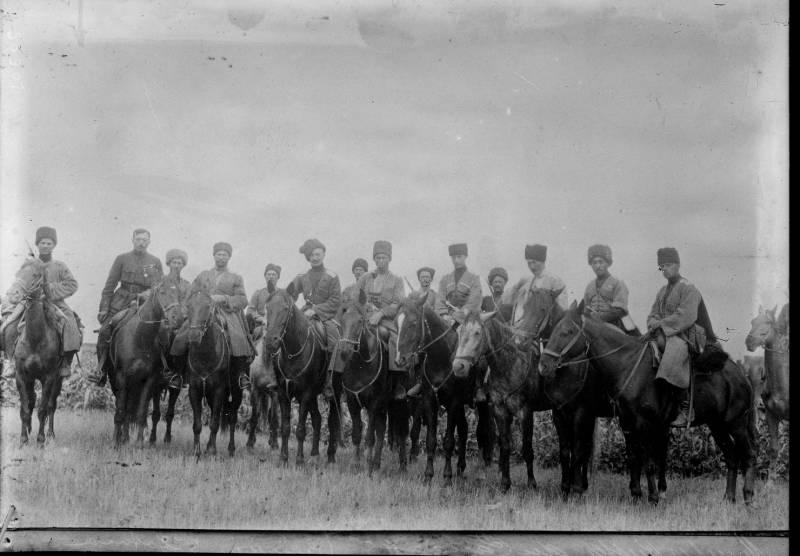
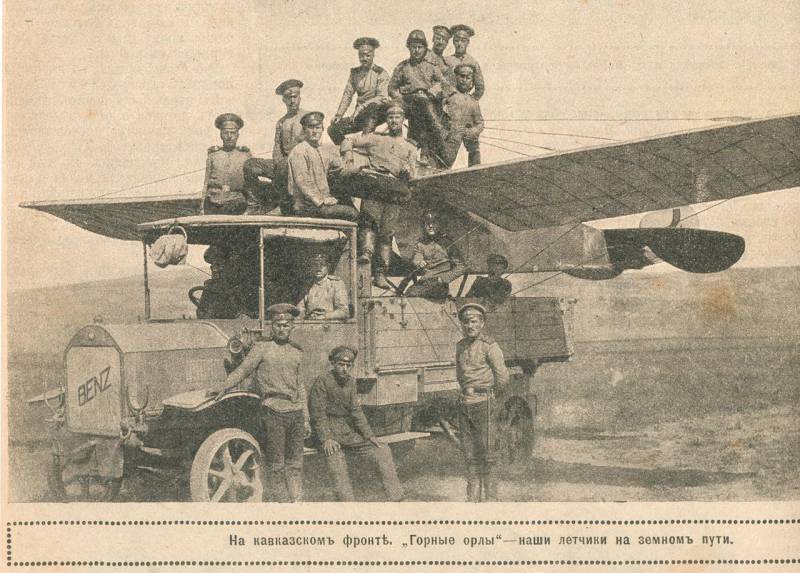
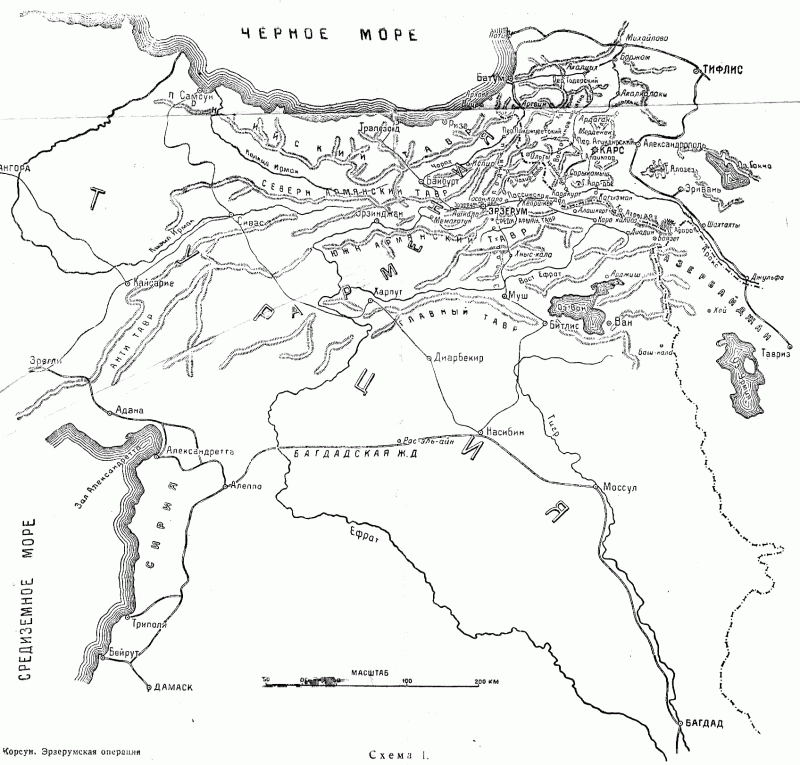
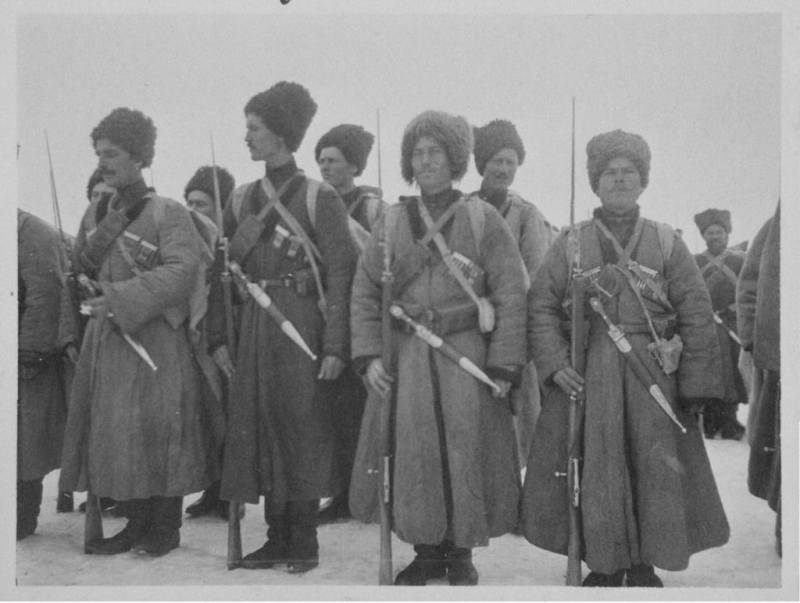
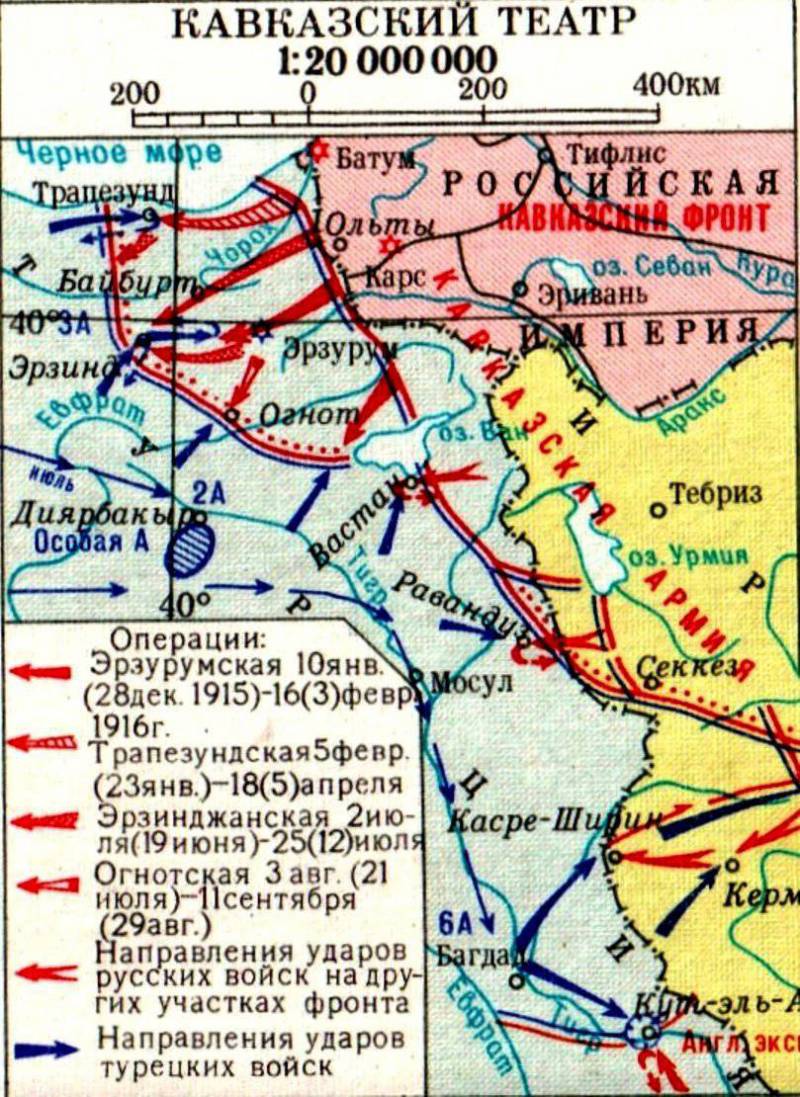
Information